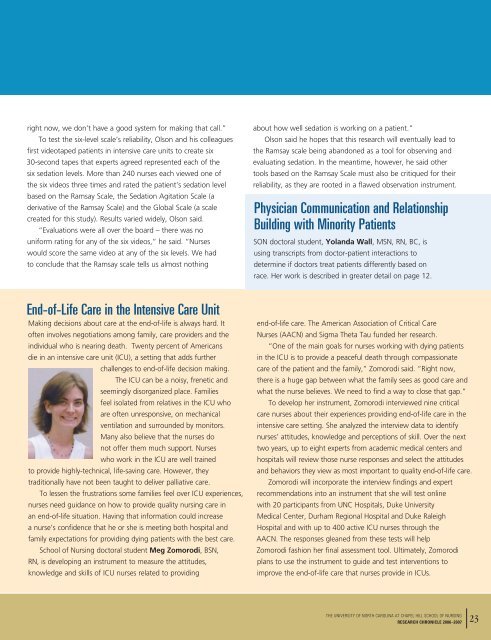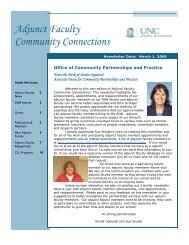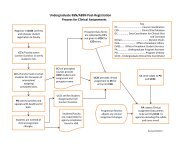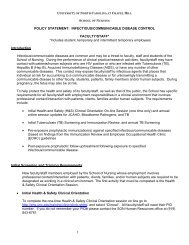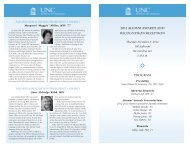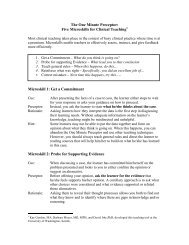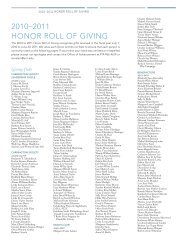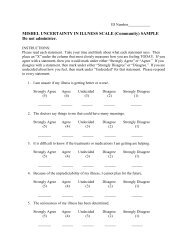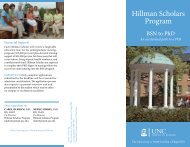Research Chronicle, 2006 - School of Nursing - University of North ...
Research Chronicle, 2006 - School of Nursing - University of North ...
Research Chronicle, 2006 - School of Nursing - University of North ...
You also want an ePaper? Increase the reach of your titles
YUMPU automatically turns print PDFs into web optimized ePapers that Google loves.
ight now, we don’t have a good system for making that call.”<br />
To test the six-level scale’s reliability, Olson and his colleagues<br />
first videotaped patients in intensive care units to create six<br />
30-second tapes that experts agreed represented each <strong>of</strong> the<br />
six sedation levels. More than 240 nurses each viewed one <strong>of</strong><br />
the six videos three times and rated the patient’s sedation level<br />
based on the Ramsay Scale, the Sedation Agitation Scale (a<br />
derivative <strong>of</strong> the Ramsay Scale) and the Global Scale (a scale<br />
created for this study). Results varied widely, Olson said.<br />
“Evaluations were all over the board – there was no<br />
uniform rating for any <strong>of</strong> the six videos,” he said. “Nurses<br />
would score the same video at any <strong>of</strong> the six levels. We had<br />
to conclude that the Ramsay scale tells us almost nothing<br />
End-<strong>of</strong>-Life Care in the Intensive Care Unit<br />
Making decisions about care at the end-<strong>of</strong>-life is always hard. It<br />
<strong>of</strong>ten involves negotiations among family, care providers and the<br />
individual who is nearing death. Twenty percent <strong>of</strong> Americans<br />
die in an intensive care unit (ICU), a setting that adds further<br />
challenges to end-<strong>of</strong>-life decision making.<br />
The ICU can be a noisy, frenetic and<br />
seemingly disorganized place. Families<br />
feel isolated from relatives in the ICU who<br />
are <strong>of</strong>ten unresponsive, on mechanical<br />
ventilation and surrounded by monitors.<br />
Many also believe that the nurses do<br />
not <strong>of</strong>fer them much support. Nurses<br />
who work in the ICU are well trained<br />
to provide highly-technical, life-saving care. However, they<br />
traditionally have not been taught to deliver palliative care.<br />
To lessen the frustrations some families feel over ICU experiences,<br />
nurses need guidance on how to provide quality nursing care in<br />
an end-<strong>of</strong>-life situation. Having that information could increase<br />
a nurse’s confidence that he or she is meeting both hospital and<br />
family expectations for providing dying patients with the best care.<br />
<strong>School</strong> <strong>of</strong> <strong>Nursing</strong> doctoral student Meg Zomorodi, BSN,<br />
RN, is developing an instrument to measure the attitudes,<br />
knowledge and skills <strong>of</strong> ICU nurses related to providing<br />
about how well sedation is working on a patient.”<br />
Olson said he hopes that this research will eventually lead to<br />
the Ramsay scale being abandoned as a tool for observing and<br />
evaluating sedation. In the meantime, however, he said other<br />
tools based on the Ramsay Scale must also be critiqued for their<br />
reliability, as they are rooted in a flawed observation instrument.<br />
Physician Communication and Relationship<br />
Building with Minority Patients<br />
SON doctoral student, Yolanda Wall, MSN, RN, BC, is<br />
using transcripts from doctor-patient interactions to<br />
determine if doctors treat patients differently based on<br />
race. Her work is described in greater detail on page 12.<br />
end-<strong>of</strong>-life care. The American Association <strong>of</strong> Critical Care<br />
Nurses (AACN) and Sigma Theta Tau funded her research.<br />
“One <strong>of</strong> the main goals for nurses working with dying patients<br />
in the ICU is to provide a peaceful death through compassionate<br />
care <strong>of</strong> the patient and the family,” Zomorodi said. “Right now,<br />
there is a huge gap between what the family sees as good care and<br />
what the nurse believes. We need to find a way to close that gap.”<br />
To develop her instrument, Zomorodi interviewed nine critical<br />
care nurses about their experiences providing end-<strong>of</strong>-life care in the<br />
intensive care setting. She analyzed the interview data to identify<br />
nurses’ attitudes, knowledge and perceptions <strong>of</strong> skill. Over the next<br />
two years, up to eight experts from academic medical centers and<br />
hospitals will review those nurse responses and select the attitudes<br />
and behaviors they view as most important to quality end-<strong>of</strong>-life care.<br />
Zomorodi will incorporate the interview findings and expert<br />
recommendations into an instrument that she will test online<br />
with 20 participants from UNC Hospitals, Duke <strong>University</strong><br />
Medical Center, Durham Regional Hospital and Duke Raleigh<br />
Hospital and with up to 400 active ICU nurses through the<br />
AACN. The responses gleaned from these tests will help<br />
Zomorodi fashion her final assessment tool. Ultimately, Zomorodi<br />
plans to use the instrument to guide and test interventions to<br />
improve the end-<strong>of</strong>-life care that nurses provide in ICUs.<br />
THE UNIVERSITY OF NORTH CAROLINA AT CHAPEL HILL SCHOOL OF NURSING<br />
RESEARCH CHRONICLE <strong>2006</strong>–2007<br />
23


